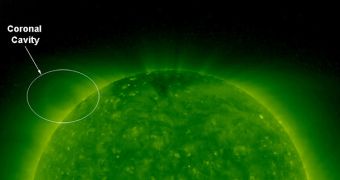Solar physicists at the American space agency are currently employing all spacecraft at their disposal to analyze structures called coronal prominence cavities. These phenomena are poorly understood at this point, although they play a role in the development of coronal mass ejections (CME).
By figuring out what makes coronal cavities tick, experts believe that they will be able to gain additional insights into the nature and behavior of CME. This will help them become capable of predicting space weather with increased accuracy.
The solar surface is usually far from what you would call calm. Giant columns of superheated gas called plasma jump from its surface, sometimes escaping into space, and sometimes falling back.
At times, some of these prominences develop inside larger plasma structures, gaining the appearance of a filament inside a light bulb. The empty area inside the “bulb” is what experts call a coronal cavity.
Over the years, as increasing volumes of data on solar activity became available, experts discovered that these cavities often formed the point of origin for CME – phenomena that see massive volumes of highly-charged particles being ejected from the Sun.
When these particle clouds collide with Earth's magnetosphere, they create interferences that can hamper communications satellites, power grids, and endanger astronauts aboard the International Space Station (ISS), in low-Earth orbit.
“We don't really know what gets these CME going. So we want to understand their structure before they even erupt, because then we might have a better clue about why it's erupting and perhaps even get some advance warning on when they will erupt,” says Terry Kucera.
The expert holds an appointment as a solar scientist at the NASA Goddard Space Flight Center (GSFC), in Greenbelt, Maryland. He and his team published a new paper on the temperatures of coronal cavities in the September 20 issue of the esteemed Astrophysical Journal.
Their research included data from the NASA Solar Terrestrial Relations Observatory (STEREO), the ESA/NASA Solar and Heliospheric Observatory (SOHO), the JAXA/NASA mission Hinode, and the Mauna Loa Solar Observatory.
“Our point with all of these research projects into what might seem like side streets, is ultimately to figure out the physics of magnetic fields in the corona,” says Sarah Gibson, a High Altitude Observatory (HAO) solar scientist based at the National Center for Atmospheric Research, in Colorado.
“Sometimes these cavities can be stable for days and weeks, but then suddenly erupt into a CME. We want to understand how that happens. We’re accessing so much data, so it’s an exciting time – with all these observations, our understanding is coming together to form a consistent story,” she concludes.

 14 DAY TRIAL //
14 DAY TRIAL //